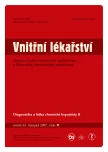Utilisation of Glykogen Phosphorylase BB measurement in the diagnosis of acute coronary syndromes in the event of chest pain
Authors:
B. Lačňák 1; D. Stejskal 1,2; L. Jedelský 2; M. Karpíšek 3; L. Šprongl 4
Authors‘ workplace:
Interní oddělení nemocnice Šternberk, přednosta prim. MUDr. Bořek Lačňák
1; Oddělení laboratorní medicíny nemocnice Šternberk, přednosta doc. MUDr. David Stejskal, Ph. D.
2; Ústav humánní farmakologie a toxikologie Farmaceutické fakulty Veterinární a farmaceutická univerzity Brno, vedoucí Ing. Michal Karpíšek
3; Centrální laboratoře Šumperské nemocnice, a. s., Šumperk, přednosta Ing. Luděk Šprongl
4
Published in:
Vnitř Lék 2007; 53(11): 1164-1169
Category:
Original Contributions
Overview
Introduction:
Glykogen Phosphorylase BB is considered a timely and specific marker of acute coronary syndrome. A kit for measuring Glykogen Phosphorylase BB in routine diagnosis has been released recently.
Objective of the study:
To test the utilisation of Glykogen Phosphorylase BB measurement in the diagnosis of acute coronary syndrome.
Method:
70 patients with suspected acute coronary syndrome were tested. A final diagnosis of acute coronary syndrome/non-coronary difficulties was made according to ESC/ACC/AHA criteria. Measurements of troponin I, myoglobin and GPBB in venous plasma (heparin-lithium) were taken for all probands on admission and two and six hours later.
Results:
Individuals with acute coronary syndrome (n = 52) had significantly higher levels of Glykogen Phosphorylase BB on admission and 2 hours after admission (21.9 vs 6.2; 18.7 vs 5.9 μg/l; p < 0.01). Levels of Glykogen Phosphorylase BB had a greater diagnostic effectiveness for the presence of acute coronary syndrome than levels of troponin I (threshold below ROC curve 0.89 vs. 0.78; 0.87 vs. 0.67). In the first two hours after admission, only levels of Glykogen Phosphorylase BB were included as independent variables in the regression model for the incidence of acute coronary syndrome (p<0.05). When the group of patients with myocardial necrosis (n = 39; acute myocardial infarction without ST elevations on ECG; NSTEMI) is removed from the group with acute coronary syndrome, it was found that only GPBB and cTnI were independent variables in the regression model on initial testing and after two hours. After adjusting GPBB to cTnI, significantly higher levels of GPBB adjusted to troponin I were found in persons with NSTEMI (14.5 vs –48.0; p < 0.01).
Conclusion:
Measurement of Glykogen Phosphorylase BB has excellent effectiveness independently of troponin in the first hours after the onset of acute coronary syndrome and should ensure the correct diagnosis of acute coronary syndrome in combination with troponin.
Key words:
Glykogen Phosphorylase – acute coronary syndromes – non-STEMI – coronary markers
Sources
1. Diagenics. Online: http://www.diagenics.de
2. Apple FS, Wu AHB, Mair J et al. Future Biomarkers for Detection of Ischemia and Risk Stratification in Acute Coronary Syndrome. Clin Chem 2005; 51 : 810-824.
3. Hofmann U, Rabitzsch G, Loster K et al. Immunenzymometric assay for the heart specific glycogen phosphorylase BB in human serum using monoclonal antibodies. Biomed Biochim Acta 1989; 48 : 132-136.
4. Kemp M, Donova J, Higham H et al. Biochemical markers of myocardial injury. Br J Anaesth 2004; 93 : 63-73.
5. Mair J. Glycogen phosphorylase isoenzyme BB to diagnose ischaemic myocardial damage. Clin Chim Acta 1998; 272 : 79-86.
6. Mair P, Mair J, Krause EG et al. Glycogen phosphorylase isoenzyme BB mass release after coronary artery bypass grafting. Eur J Clin Chem Clin Biochem 1994; 32 : 543-547.
7. Mair J, Puschendorf B, Amidy J et al. Release of glycogen phosphorylase in patients with unstable angina and transient ST-T alterationsBr Heart J 1994; 72 : 125-127.
8. Peetz D, Post F, Schinzel H et al. Glycogen phosphorylase BB in acute coronary syndromes. Clin Chem Lab Med 2005; 43 : 1351-1358.
9. Rabitzsch G, Mair J, Lechleitner P et al. Immunoenzymometric assay of human glycogen phosphorylase isoenzyme BB in diagnosis of ischemic myocardial injury. Clin Chem 1995; 41 : 966-978.
10. Stejskal D, Lačňák B, Jedelský L et al. The utilisation of glycogen phosphorylase BB measurement with POCT in the diagnosis of acute coronary syndromes. A comparison with results of ELISA. Biomed Papers 2007 (v recenzním řízení).
11. Wu AHB, Apple FS, Gibler WB et al. National Academy of Clinical Biochemistry Standards of Laboratory Practice: Recommendations for the Use of Cardiac Markers in Coronary Artery Diseases. Clin Chem 1999; 45 : 1104-1121.
12. Achermann M. Doporučení k diagnostice a léčbě nestabilní anginy pectoris - revize 2002. Online: http://www.kardio-cz.cz/index.php?&desktop=clanky&action=view&id=86
13. Pettila I, Penttila K, Rantanen T. Laboratory diagnosis of patients with acute chest pain. Clin Chem Lab Med 2000; 38 : 187-197.
14. Lu Y, Yu HL, Yang S. Relationship between glycogen phosphorylase BB and cardiac ischemic area or infarction area in experimental acute myocardial infarction. Zhongguo Wei Zhong Bing Ji Jiu Yi Xue 2005; 17 : 433.
15. Wu AH. The ischemia-modified albumin biomarker for myocardial ischemia. MLO Med Lab Obs 2003; 35 : 36-38.
16. Ortak M, Holle AK, Lehmann W et al. GPBB - a promising cardiac marker in early detection of acute myocardial infarction. Clin Res Cardiol 2007; 96(Suppl 1): V1917.
17. Klabunde RE. Cardiovascular Physiology Concepts. Online: http://www.cvphysiology.com/Blood%20Pressure/BP006.htm
18. Albert JS, Thygesen K, Altman E et al. Myocardial infarction redefined: a consensus document of The Joint European Society of Cardiology/American College of Cardiology Committee for the redefinition of myocardial infarction. J Am Coll Cardiol 2000; 36 : 959-969.
Labels
Diabetology Endocrinology Internal medicineArticle was published in
Internal Medicine

2007 Issue 11
Most read in this issue
- Superior vena cava syndrome (definition, aetiology, physiology, symptoms, diagnosis and treatment)
- Rituximab (MabThera®) – a new biological medicine in rheumatoid arthritis therapy
- Diagnostic benefit of the use of implanted loop recorder (Reveal Plus) for patients with syncope with unclear aetiology
- Endoscopic diagnosis and treatment of biliary complications after laparoscopic cholecystectomy
